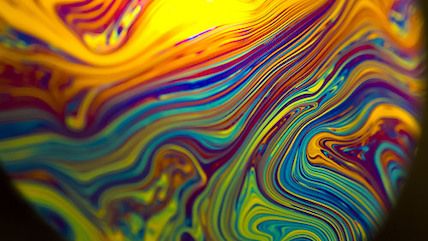Why LSD Trips Last Forever, What Happens When You Inject Psilocybin
And other fun notes from the world's largest gathering of psychedelic researchers.

The world's leading researchers of psychedelic drugs met in Oakland, Calif., this past weekend at Psychedelic Science 2017, sponsored by the Multidisciplinary Association of Psychedelic Science (MAPS). I attended for for a story I'm working on about MDMA-assisted therapy, and thought I'd share some items from my notebook.
Why do LSD trips last so long? Psilocybin and MDMA are both active in the body for two to three hours when administered in tens of milligrams. LSD, meanwhile, is administered in micrograms (1 mcg is .001 mg) and yet the drug experience can exceed eight hours.
UNC-Chapel Hill's Dave Nichols, a medicinal chemist who's been studying psychedelics for decades, shared some new research that explains why. Imagine a carnivorous pitcher plant. That's the 5-HT2B serotonin receptor. Lysergic acid diethylamide, LSD, is a fly. Instead of attaching to the top of the receptor, the LSD molecule gets pulled inside and the top of the receptor closes around it. Basically, LSD trips last forever because the drug gets trapped in a brain cage. (Nichols' team published their findings in January. You can read more about them here.)
What happens when you inject psilocybin? The psilocybin-assisted therapy study conducted by Johns Hopkins University--which found that moderate and high doses of psilocybin, in conjunction with psychotherapy, reduced anxiety and depression in cancer patients--used gel caps as the method of administration. Most recreational users just eat the mushrooms or brew them into tea. Over in Europe, however, researchers have experimented with intravenous administration. Apparently, it's like "rocketing [someone] out of a cannon"; the come-up takes place over roughly a minute, rather than half an hour. Well, duh. Except, at a Q&A later in the day, Nichols revealed LSD doesn't work any quicker when administered via IV. It truly is the Good Friday mass of psychedelic drugs.
Prohibition makes this kind of research stupidly expensive: The Imperial College of London pays 1,500 British Pounds per dose of UK Home Office-approved psilocybin, according to researcher Leor Roseman, who noted that street prices are a fraction of that. (The ICL is currently doing a ton of interesting psychedlelic research right now.)
I'm not sure how easy it is to obtain isolated psilocybin on the black market, but the mushrooms themselves grow on cow shit and dead plant matter. Stateside, dried psilocybin shrooms go for about $5-$10 per gram, according to various mycophile message boards and my own independent research. The most common (and cheapest) strains contain about .6 mg of psilocybin per gram of dry weight, and more exotic (read: expensive) strains have as much as 1.6 mg per gram. The Home Office essentially charged the ICL a penalty for studying a drug that should never have been banned. This kind of oblique research penalty is not unique to psilocybin, or to the UK. Cannabis researchers in the U.S. have to buy their bud from NIDA's monopoly operation, and it is not quality stuff.
Psychedelic researchers are cautiously optimistic about Scott Gottlieb at FDA: Gottlieb, Trump's nominee for head of the Food and Drug Administration, has said he'd like to speed up the drug approval process, perhaps using more flexible clinical trial designs.
What does this mean for MAPS, currently sponsoring clinical trials for MDMA-assisted psychotherapy? MAPS clinical sites recently completed stage two trials, and the group is now negotiating stage three protocols with the FDA. All they really need is for the agency to treat them like it would any other sponsor of a new drug application. That may sound like a small ask, but the FDA's history with psychedelic researchers is replete with periods of capricious obstructionism. The agency environment changed in the mid 2000s, leading to the current research boon. MAPS Founder Rick Doblin expressed optimism that things will continue apace under Gottlieb.
Placing a marker: MDMA will beat marijuana out of schedule I: The FDA-approval timeline MAPS shared with conference attendees has MDMA getting moved from schedule I of the Controlled Substances Act to schedule II sometime around 2021. It would then be available by prescription. I'll be looking at the specifics of that process in an upcoming feature, but for now, let's say everything breaks MAPS' way, and MDMA is a legal prescription drug in 2021. Is marijuana still federally prohibited? I'm betting it is.
Even though marijuana and MDMA are both misclassified as inherently dangerous and therapeutically useless, pot law reform has always looked closest to the ground. But FDA will not reschedule whole-plant marijuana without clinical trials. (MAPS is currently sponsoring such a trial, though it won't be completed by 2021.) That leaves Congress and the amending of the Controlled Substances Act. I would love to be wrong, but if the glacial pace of federal sentencing reform has taught me anything, it's that Congress creates new criminal penalties quickly and casually, but moves like a crippled sloth when reducing or eliminating existing ones.



Show Comments (26)